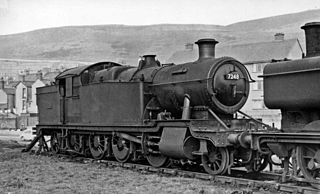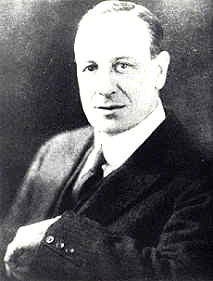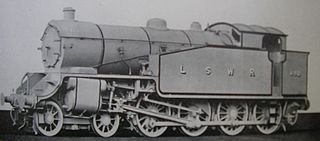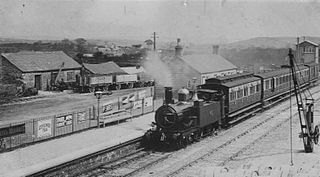Related Research Articles

The first Locomotives of the Great Western Railway (GWR) were specified by Isambard Kingdom Brunel but Daniel Gooch was soon appointed as the railway's Locomotive Superintendent. He designed several different 7 ft 1⁄4 in broad gauge types for the growing railway, such as the Firefly and later Iron Duke Class 2-2-2s. In 1864 Gooch was succeeded by Joseph Armstrong who brought his standard gauge experience to the workshops at Swindon. To replace some of the earlier locomotives, he put broad gauge wheels on his standard gauge locomotives and from this time on all locomotives were given numbers, including the broad gauge ones that had previously carried just names.
The Great Western Railway 3800 Class, also known as the County Class, were a class of 4-4-0 steam locomotives for express passenger train work introduced in 1904 in a batch of ten. Two more batches followed in 1906 and 1912 with minor differences. They were designed by George Jackson Churchward, who used standard components to produce a four-coupled version of his Saint Class 4-6-0s.

The Great Western Railway 4900 Class or Hall Class is a class of 4-6-0 mixed-traffic steam locomotives designed by Charles Collett for the Great Western Railway. A total of 259 were built at Swindon Works, numbered 4900–4999, 5900–5999 and 6900–6958. The LMS Stanier Class 5 4-6-0 and LNER Thompson Class B1 both drew heavily on design features of the Hall Class. After nationalisation in 1948, British Railways gave them the power classification 5MT.

The Great Western Railway (GWR) 7200 Class is a class of 2-8-2T steam locomotive. They were the only 2-8-2Ts built and used by a British railway, and the largest tank engines to run on the Great Western Railway.

The GWR 5600 Class is a class of 0-6-2T steam locomotive built between 1924 and 1928. They were designed by Charles Collett for the Great Western Railway (GWR), and were introduced into traffic in 1924. After the 1923 grouping, Swindon inherited a large and variable collection of locomotives from historic Welsh railway companies, which did not fit into their standardisation programme. GWR boiler inspectors arrived en masse and either condemned the original locomotives or had them rebuilt. The systematic destruction of many examples of locomotives, most still in serviceable condition, followed, but various were worked alongside 5600 Class.

The Great Western Railway (GWR) 2221 Class or County Tank was a class of 4-4-2T steam locomotive, effectively a tank engine version of the 3800 "County" Class 4-4-0 tender locomotives. The two classes had different boilers, standard no 4 for the tender locomotive, and the smaller standard no 2 for the tank. 2230 was fitted with the larger boiler when new, but this was unsuccessful and was quickly altered.

The Great Western Railway (GWR) 4500 Class or Small Prairie is a class of 2-6-2T steam locomotives.

The Great Western Railway (GWR) 2301 Class or Dean Goods Class is a class of British 0-6-0 steam locomotives.

Charles Benjamin Collett was Chief Mechanical Engineer of the Great Western Railway from 1922 to 1941. He designed the GWR's 4-6-0 Castle and King Class express passenger locomotives.

The Great Western Railway (GWR) 5800 Class was a class of twenty 0-4-2T steam tank locomotives. They were built by the GWRs Swindon Works in 1933 and were used for light branch line work. They were similar to the GWR 1400 Class, but lacked the equipment for working autotrains. The last survivor of the class, number 5815, was with withdrawn in 1961. No members of the class were preserved.
The GWR was the longest-lived of the pre-nationalisation railway companies in Britain, surviving the 'Grouping' of the railways in 1923 almost unchanged. As a result, the history of its numbering and classification of locomotives is relatively complicated. This page explains the principal systems that were used.

The GWR 388 class was a large class of 310 0-6-0 goods locomotives built by the Great Western Railway. They are sometimes referred to as the Armstrong Goods or Armstrong Standard Goods to differentiate from the Gooch Goods and Dean Goods classes, both of which were also large classes of standard goods locomotives.
The 3521 Class were forty tank locomotives designed by William Dean to haul passenger trains on the Great Western Railway. They were introduced as 0-4-2T locomotives in 1887, but were quickly altered to become 0-4-4Ts to improve their running. Following two serious accidents they were further altered from 1899 to run as 4-4-0 tender locomotives, in which form the last was withdrawn in 1934.

The 517 Class were small 0-4-2T tank engines designed by George Armstrong for local passenger work on the Great Western Railway. They were built at Wolverhampton Works and were outshopped between 1868 and 1885. They were built in thirteen lots commencing with 517–528 and ending with 1477–1488 in 1884–1885.

The LSWR G16 class was a class of steam tank locomotives with a 4-8-0T wheel arrangement. It was designed by Robert Urie and introduced in 1921 specifically for heavy shunting over humps at Feltham marshalling yard, on the London and South Western Railway (LSWR). They were based upon Urie's previous S15 class freight design, and apart from several periods of operating elsewhere on the LSWR and Southern railway network, they remained at Feltham for most of their operational careers.

The GWR 455 Class, also called the "Metropolitan" or "Metro" Tanks, was a series of 140 2-4-0T locomotives built for the Great Western Railway, originally for their London suburban services, including running on the underground section of the Metropolitan Railway, the source of their nickname. Later on the class was seen on many other parts of the GWR system. Sixty "Metro" Tanks were built, from 1868 onwards, during the lifetime of their designer, Joseph Armstrong. His successor William Dean regarded the class so highly that he would add a further 80, the final 20 examples appearing as late as 1899. The "Metros" were all built at Swindon Works, in nine lots of ten or 20 engines each.
President, number 103, and Alliance, number 104 were locomotives of the Great Western Railway. George Jackson Churchward, Chief Mechanical Engineer of the Great Western Railway, was given authority to purchase three French de Glehn-du Bousquet four-cylinder compound locomotives, in order to evaluate the benefits of compounding. The first locomotive, no.102 La France, was delivered in 1903. Two further locomotives, nos. 103 and 104, were purchased in 1905. These were similar to the Paris-Orleans Railway's 3001 class, and slightly larger than 102. As with no. 102, these were built by Société Alsacienne de Constructions Mécaniques. They had two low-pressure cylinders fitted between the frames, and two high-pressure cylinders outside. The low-pressure cylinders drove the front driving wheels while the high-pressure cylinders drove the rear driving wheels. An external steam pipe was mounted just in front of the dome, looking rather similar in appearance to a top feed. In 1907 No. 104 was fitted with an unsuperheated Swindon No. 1 boiler, President herself being similarly reboilered in February 1910 and receiving a superheated boiler in January 1914. In 1926, the three locomotives were based at Oxford shed. In practice, they did not provide any significant improvement in either performance or economy compared to No 171 Albion, Churchward's prototype 4-6-0, which was converted to a 4-4-2 specifically for comparison with the French locomotives.

The GWR 101 Class consisted of a single experimental 0-4-0T side-tank steam locomotive. It was built at GWR Swindon Works under the direction of George Jackson Churchward in June 1902.
The 4600 Class was a 4-4-2T steam locomotive built by the Great Western Railway in 1913. It was one of the GWR standard classes with two outside cylinders.
References
- Allcock, N. J.; Davies, F. K.; le Fleming, H. M.; Maskelyne, J. N.; Reed, P. J. T.; Tabor, F. J. White, D. E. (ed.). The Locomotives of the Great Western Railway, part one: Preliminary Survey. Kenilworth: RCTS.
- Ferris, Robert (2015a). "Birmingham Snow Hill Station: gwrbsh1765". WarwickshireRailways.com. Retrieved 1 January 2021.
- Ferris, Robert (2015b). "Birmingham Snow Hill Station: gwrbsh1766". WarwickshireRailways.com. Retrieved 1 January 2021.
- Ferris, Robert (2015c). "Birmingham Snow Hill Station: gwrbsh1791". WarwickshireRailways.com. Retrieved 1 January 2021.
- Haresnape, Brian; Swain, Alec (1976). Churchward locomotives : a pictorial history. London: I. Allan. ISBN 0-7110-0697-0.
- Haresnape, Brian (1978). Collett & Hawksworth locomotives : a pictorial history. London: I. Allan. ISBN 0-7110-0869-8.
- Holcroft, Harold (1957). An Outline of Great Western Railway Locomotive Practice. London: Locomotive Publishing Co Ltd.
- "Tyseley Shed: gwrt2388". WarwickshireRailways.com. 2015. Retrieved 1 January 2021.